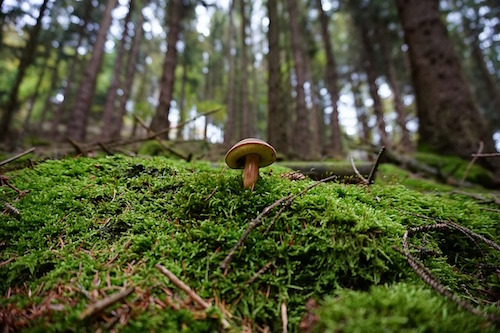Hunting on the forest floor

I enjoy watching documentaries about the history of man. Anything about Dinosaurs and archeology are personal favourites. The definition of Hunter-Gatherers is nomadic people who live chiefly by hunting, fishing, and harvesting wild food.
Have you heard of the term foraging? It has a way better definition. Yes, acquiring plant-based foods is one but the word is also associated with plundering, rummaging (love that word) and wandering.
My friend Christie took me on a guided foraging tour and I loved it!! I want to share some of the cool things we learned.
I will preface this with a caution – there are foraging groups and experienced guides who are excellent resources. Do not put things in your mouth if you aren’t sure what they are – especially mushrooms!
- Wild Ginger literally grows like a carpet on the forest floor. It has heart-shaped leaves that are inedible. The roots run along the surface and you can slice out pieces between the roots that connect to the ground. There will be a section maybe 1-2” long that you can slip your thumb under and is bound on either side. Cut that bit out so the plant is preserved. Scrape the outer casing and use for tea (or in my case rhubarb jam).
- Watercress grows along creek beds. The wilted nonsense in stores is not worth trying to revive. It grows 10-20” tall but only eat the top leaves, which are more tender. The taste is stronger than arugula.
- We tasted Pheasant Back mushrooms. There were some growing on the side of a tree that were bigger than your head. Don’t eat those ones, they are tough. It truly tasted just like cucumber (honestly!)
- Cat tails grow alongside creeks. In the spring, you can strip away the outer leaves and eat the hearts. These also taste just like cucumber (no joke). However, a word of caution that marshes are Nature’s purifier and plants like cat tails absorb pollution. This is not a delicacy to consume in volume.
- Stinging Nettles come in two varieties. The narrow common plant makes for an excellent soup! The broad leaf can also be eaten but are significantly more painful to touch.
- You will normally find burdock growing beside nettles. It’s a broad leaf plant that I knew as Doc-leaf growing up in England. We had nettles in our school play yard and you learned early to rip off a doc leaf, spit on it and rub it on the inflammation – it would go away instantly. Nature’s amazing companion plants and an awesome example of herbal medicine.
What was the biggest lesson that I learned?
Our nomadic ancestors travelled vast distances to find their food. We walked for over 3 hours and I came back with mostly nettles and a few pieces of ginger to sample. Not much yield for how much time I spent rooting around the forest floor. I can easily understand their desire to cultivate agriculture and grow their own food.
Have you ever been foraging? Is there a patch in the forest near your house of raspberries or nettles? Hit reply or leave a comment with your favourite wild food that you’ve eaten.
